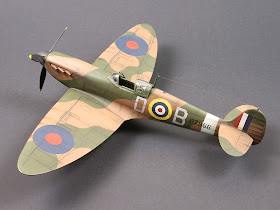Read Part III Here
Two years ago I was inspired by the great collection of aircraft I had seen at Eagle Quest to start the build of the Tamiya BF109 E3. Unfortunately the inspiration didn't last long, and after building the cockpit she became a shelf queen.
After priming the plane with Tamiya white primer, I used Tamiya XF-1 Flat Black to outline and pre-shade all panel lines.
Using Model Master acrylic paints, I began applying the main colors, starting with RLM 65 Hellblau for the areas on the bottom of the aircraft and the sides. For this model, I shot all of my main colors with an Iwata at 20psi. I thinned my paints using Model Master acrylic thinner at a ratio of about 20% thinner to paint.
In the next step, I cut out masks using printer paper in order to be able to create a "soft" hard edge scheme, as I'm building the Adolf Galland version of the plane that comes in the box (same as the box art). The light color in the camo is Model Master RLM 02 Grau while the dark color is Model Master RLM 71 Dunkelgrun.
For all of the three base colors I have allowed the pre-shade to slightly show through (not too strong!) and I shot the middle of the panels with lightened versions of the base coat colors to begin a bit of a contrast/weathering effect. I kept both of these techniques to a minimum as this plane was still relatively new when it saw service.
After a coat of gloss using Future floor wax, I applied the decals over a three day period using a mix of decals supplied with the kit and decals from my aftermarket stash. Micro-Set and Micro-Sol were used to ensure snug decals without silvering.
Once the decals had a day to set, I re-applied future to lock them in and gave it another day to dry. Using MIG dark wash and MIG thinner for washes, I spent a few days bringing out all of the panel lines. This was allowed to dry then followed with Vallejo semi-gloss varnish thinned with Vallejo thinners (and with a drop of slow dry added to help avoid "white specks") shot through the Iwata at about 20psi.
I hope to complete the model this week and Part III will cover final assembly, weathering, and some shots of the finished result.




















